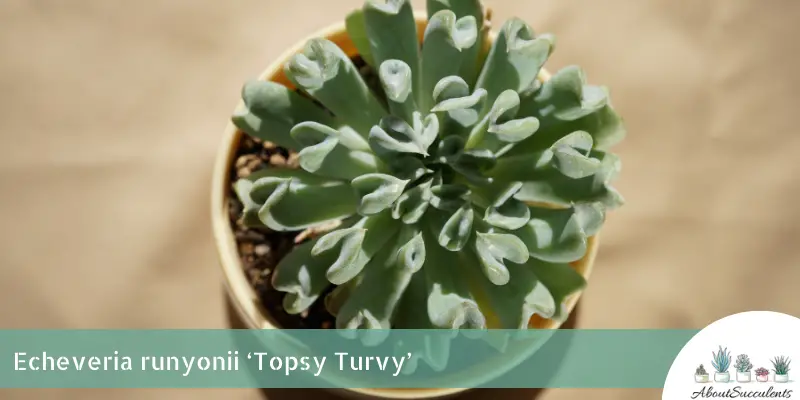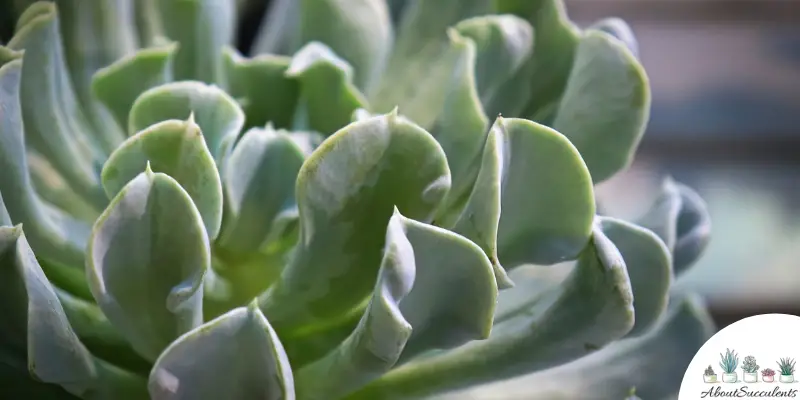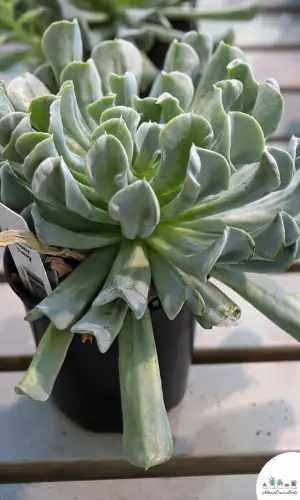
Echeveria Runyonii is an adorable succulent that has always delighted horticulturists and budding hobbyists.
This wonderful succulent plant goes by many nicknames such as “Topsy Turvy”, “Silver Spoons Echeveria”, and “Upside-Down Echeveria”. Perhaps the most appropriate is “Mexican Hens and Chicks: because it produces many offsets or pups that assure growers of easy propagation.
Topsy Turvy grows fast and features rosettes that have a diameter of 10cm (4”). The leaves of this Echeveria vary in color from bluish-green to silver grey with tips that might have a hint of pink.
Fully-grown Silver Spoons Echeveria can reach a height of 15cm (6”) with a width of 20cm (8”). It produces eye-catching bright yellow and orange flowers in the spring and late summer seasons.
Echeveria Runyonii was named by American Botanist, Joseph Nelson Rose, after the Texas photographer, Robert Runyon who collected the specimen in Tamaulipas, Mexico in 1922.
Topsy Turvy is native to Mexico and belongs to the Crassulaceae family. It has won the distinguished Award of Garden Merit of the Royal Horticultural Society from the UK and was Garden Path magazine’s “Plant of the Month” in October 2010.
General Information:
Also known as: Topsy Turvy, Mexican ‘Hens and Chicks’, Silver Spoons Echeveria, and Upside-Down Echeveria.
Plant Family: Crassulaceae
Origin: Mexico.
Height: 15cm (6”)
Exposure: Full to partial sunlight for up to 6 hours.
Water Needs: Sensitive to overwatering; only water the soil when it’s completely dry.
Soil Type: Sandy soil or cactus potting mix with added ingredients such as perlite and pumice to improve drainage.
Soil pH: 5.6 to 6.0
How to Grow and Care for Echeveria Runyonii ‘Topsy Turvy’

Echeveria Runyonii is an excellent choice of succulent plant because it’s easy to grow and care for.
Landscapers love them because Topsy Turvy attracts hummingbirds that add more color and life to your outdoor garden.
Silver Spoons Echeveria also makes excellent houseplants. The charming appearance will surely elicit conversation from your guests.
Sunlight
Echeveria Runyonii loves to bask in the warmth of the morning sunlight. It needs the rays of the sun to achieve maximum beauty. If your garden only receives partial sunlight, that’s fine enough for Silver Spoons Echeveria. Just make sure the succulent plant gets 5-6 hours of morning sunlight every day.
As a houseplant, place Topsy Turvy on a windowsill that gets the morning sun for 5 to 6 hours per day. In the summertime, you might have to move Echeveria if the sun’s rays become too harsh.
Watering

Similar to other Echeveria succulent plants, Topsy Turvy is sensitive to getting too much water. Overwatering can lead to root rot that might quickly develop into a fungal infection.
Before watering the soil, make sure it’s 100% dry by inserting a stick 1-2” into the topsoil. If the end of the stick feels dry, it’s time to give the soil a good soaking.
If Echeveria Runyonii is housed inside a pot, check the water coming out of the drain hole. Allow a bit more water to come out of the drain hole and collect on the tray. Don’t forget to throw away the excess water on the drain tray.
Pot and Soil
Echeveria Runyonii isn’t a big succulent plant. Choose a pot that’s large enough to allow the roots to grow without getting tangled. The best pot is made of ceramic or terracotta because these materials let excess moisture evaporate quickly from the soil.
Lastly, make sure the pot has a drain hole or drain holes with a mesh cover at the bottom to let excess water come out without losing soil.
Speaking of soil, Silver Spoons Echeveria can survive in any type of soil but thrives best in sandy or cactus mix. To improve drainage, add pumice or perlite.
How to Propagate Echeveria Runyonii ‘Topsy Turvy’
Gasteria ‘Little Warty’ can be propagated Echeveria Runyonii makes it easy for you to propagate the species because it rewards you with pups or offsets that grow in abundance. You can also try to propagate Mother Hens and Chicks via leaf or stem cuttings.
Method 1: Offsets
Step 1: Gently pull out the offsets that have grown around the base of the plant.
Step 2: Give the offsets 2 to 3 days to develop hard calluses. Place them in a warm area so the offsets can dry out right away.
Step 3: Plant the offsets in well-draining soil.
Step 4: Lightly water the soil until the roots take hold.
Step 5: Once the roots are firmly planted, water the soil only when it’s 100% dry.
Method 2: Leaf Cuttings
Step 1: Cut a healthy leaf from the stem by using a sterilized and sharpened knife or garden scissors.
Step 2: Leave the cuttings in a warm and dry place for 2 to 3 days so they can develop calluses.
Step 3: Place the leaf cuttings on fresh potting soil or cactus mix.
Step 4: Keep the soil lightly moist by misting it until such time that the roots have appeared.
Step 5: When the roots have taken hold in the soil, give the succulent water only when it’s proven to be dry.
Method 3: Stem Cuttings
Step 1: Select a healthy-looking stem and cut it off by using a sterilized and sharpened knife of garden shears.
Step 2: Before planting, make sure the stem cuttings develop hard calluses by placing them in a dry and warm place.
Step 3: Place the stem cuttings on sandy or cactus soil. Water the soil frequently, but lightly, until such time that the cuttings have taken root.
Step 4: Once the roots are firmly in the soil, give it water only when its completely dry.
Frequently Asked Questions
Is Gasteria ‘Little Warty’ Toxic to Cats and Dogs?
Echeveria Runyonii ‘Topsy Turvy’ is not found on the list of plants that are toxic to cats and dogs that appear on the website of the American Society for the Prevention of Cruelty to Animals (ASPCA).
Why Is My Echeveria Runyonii ‘Topsy Turvy’ Dying?
You can lose Echeveria Runyonii if you give it too much water or if it becomes infested with disease-carrying pests.
Overwatering
Giving too much of a good thing can be deadly and that includes life-giving water. When it comes to Topsy Turvy, show it love by giving it less water. To be more accurate, only water the soil when it’s completely dry.
If the roots are kept in a moist environment for a long period of time, the cells will erupt and fungal infection will develop. The infection will spread rapidly – working its way inside the plant and manifest through discoloration in the stems and leaves.
So if you notice discoloration on the plant, remove these infected parts right away by using a sterilized pair of garden shears. Wipe the garden shears with 70% isopropyl alcohol to keep the infection from spreading.
Remove the plant from the soil and cut off the roots that have gone bad. Allow Topsy Turvy to dry out while you prepare a pot with fresh, well-draining soil.
Replant Echeveria Runyonii in its new pot and remember to water the soil only when it needs to be.
Pest Infestation
Pests such as mealybugs, spider mites, and scale insects are also attracted to Echeveria Runyonii. These insects will not only drain your beautiful succulent of its nutritious sap but it can leave substances that can lead to fungal infection.
To protect Silver Spoons Echeveria from pests, spray it with a natural insecticide or neem oil. Wipe off the white, cotton-like substances on the leaves with a cotton ball that’s soaked in 70% isopropyl alcohol.
Does Echeveria Runyonii ‘Topsy Turvy’ Produce Flowers?
Yes, Echeveria Runyonii ‘Topsy Turvy’ produces yellow and orange flowers on top of an arching inflorescence during the spring and late summer seasons.
Last Updated on June 9, 2022 by Sofia Lara